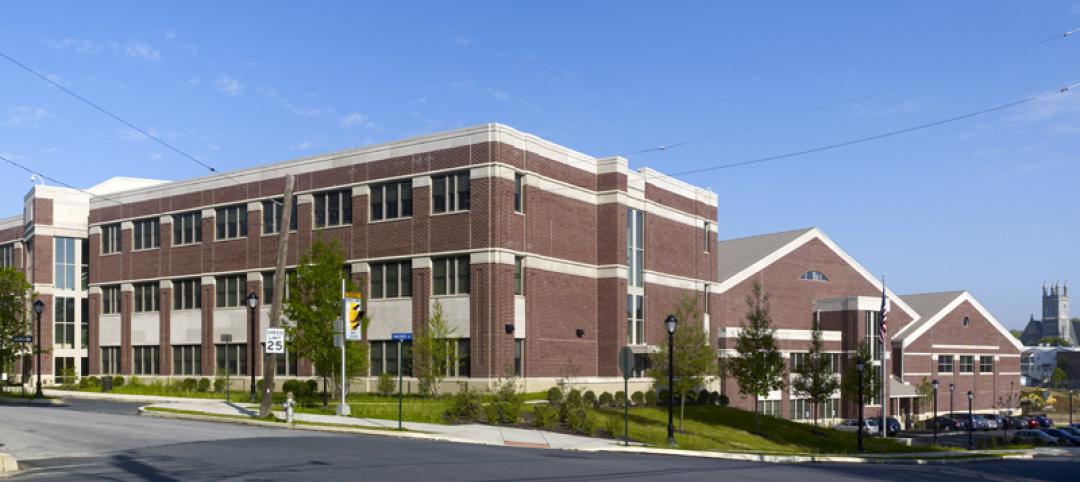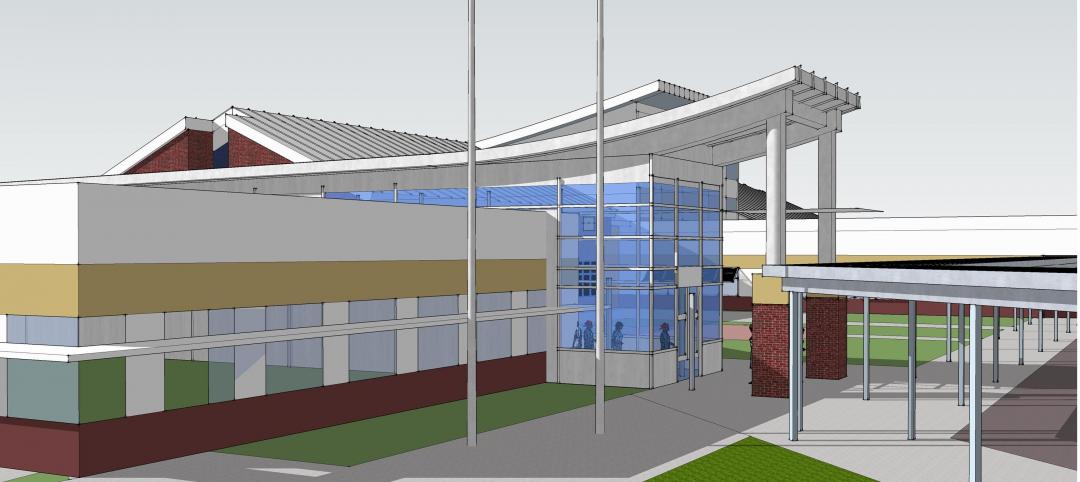 |
|
Project: California Pacific Medical Center at Cathedral Hill Architect: SmithGroup Mechanical engineer: Ted Jacobs Engineering Group Electrical engineer: Silverman & Light; Southland Industries Structural engineer: Degenkolb Engineers Contractor/CM: Herrero/Boldt Energy modeling: Gable & Associates with Guttman & Blaevoet |
It's big news in any city when a new billion-dollar hospital is announced. Imagine what it must be like to have not one, not two, but three such blockbusters in the works, each of them tracking LEED-NC Gold certification from the U.S. Green Building Council.
That's the case in San Francisco, where three new billion-dollar-plus healthcare facilities are in various stages of design and construction:
-
California Pacific Medical Center at Cathedral Hill, a private nonprofit division of Sutter Health, employing lean construction for project delivery (555 beds; 914,750 sf; $1.7 billion). CPMC will provide adult, acute, post-acute, and critical care; women and children's services (including labor and delivery and pediatric care); acute, critical, preventive, and integrative care; surgical services; outpatient diagnosis and treatment; gastrointestinal care; emergency services; and health education.
-
University of California San Francisco Medical Center at Mission Bay, a university teaching hospital utilizing integrated project delivery (289 beds; 881,000 sf; $1.6 billion). UCSF consists of a children's hospital planned for urgent and emergency care, pediatric outpatient facilities, cancer facilities, a women's cancer care center, specialty surgery, a birthing center, and outpatient services.
-
San Francisco General Hospital and Trauma Center, owned by the City and County of San Francisco, using design-assist project delivery (284 beds; 448,000 sf; $900 million). SFGH, which recently broke ground, will offer acute care, emergency services, obstetrics, pediatrics, imaging and cardiology, perioperative services, intensive care, and med/surg nursing.
 |
|
Project: University of California San Francisco Medical Center at Mission Bay Architect: Anshen+Allen with William McDonough + Partners MEP: Arup Structural engineer: Rutherford & Chekene; Arup Contractor: DPR Construction Inc. CM: Cambridge Construction Management |
When all three are completed in a few years, they will add more than 1,100 beds and upwards of 2.2 million sf of hospital space to the city's healthcare infrastructure, at a total cost exceeding $4 billion. More to the point, they will provide capacity for nearly 600,000 patient days a year.
Aside from its sheer magnitude, what is perhaps most fascinating about this mammoth undertaking is that, rather than distancing themselves from their competitors, the three Building Teams are actually sharing information and providing advice to each other to optimize their respective sustainability strategies.
This may be the first time in the history of American healthcare construction that such an approach has been taken at this scale, in a single location. It is equally remarkable that, notwithstanding the intense level of cooperation, the Building Teams have, for the most part, come up with widely different strategies for energy conservation, renewables, materials selection, and other sustainability factors. The results thus far indicate that this cooperative approach is already paying off in greener design, significant cost savings, and the potential for improved patient care.
 |
Project: San Francisco General Hospital and Trauma Center Architecture: Fong & Chan Architects Mechanical, plumbing engineer: Gayner Engineers Electrical engineer: FW Associates Structural engineer of record, LEED coordinator of record: Arup Civil engineer: Brio Engineering Associates Contractor: Webcor Builders CM: Jacobs Energy modeling: Taylor Engineering |
Adding to the richness of the whole enterprise is the robust diversity of the population these three hospitals will serve. According to Mark Palmer, LEED AP, the city's green building coordinator, the 2000 census shows whites at 49.7%, Asians at 30.8%, Hispanics/Latinos at 14.1%, and African Americans at 7.8%. Forty-six percent of San Franciscans speak a language other than English at home. “Thankfully, our hospital staffs reflect this multicultural picture,” says Palmer, who chairs the city's Municipal Green Building Task Force as well as the national USGBC Government Committee.
Another major demographic shift—one not confined to San Francisco, but certainly at work there—is the aging of the population. According to Palmer, the Association of Bay Area Governments says that the fastest-growing sector in San Francisco is the 60-and-over group—those pesky baby boomers, more and more of whom are becoming eligible for Medicare.
Finally, there's the city's estimated 73,000 healthcare uninsured. To provide a safety net for them, Mayor Gavin Newsom's administration has created “Healthy San Francisco.” The program, which is administered by the public health department, is not a health insurance plan but does provide improved access to primary and preventive care for those without coverage.
Let's zoom in on some of the key design strategies being employed in these three projects. (Note: You can learn more by viewing the webcast described on p. 36.)
 |
|
One of many collaborative design sessions held to discuss sustainability strategies for the three hospital projects totaling $4.2 billion. |
Taking a bite out of the energy load
“This has been an interesting collaboration to get into some depth on energy and begin to look at commonalities, both strategically and in energy modeling,” says SmithGroup's Russell Perry, AIA, LEED AP.
For example, CPMC, the project SmithGroup is designing, will use variable air volume, heat recovery, and displacement ventilation to reduce energy use 35% and carbon emissions 26%, according to the energy model projections. Perry notes, moreover, that the modeling has shown VAV to be so effective that it is “becoming a common strategy for all the projects, and a very useful one.”
Energy modeling showed that, whereas UCSF projected only 24% of building energy use for process/plug load, California Pacific showed this factor at 48% and San Francisco General at 47%. Perry explains that UCSF has already optimized for process and plug load in the model, whereas the other two hospitals had not. Nor have lighting and daylighting been fully optimized, which could result in additional energy savings.
 |
 |
 |
Places of respite, activity spaces, meditation areas, “outdoor rooms” (middle), and strolling gardens (top) for patients, family members, and staff at San Francisco General Hospital and UCSF Medical Center. |
Renewable energy, from three different angles
“You have three major hospitals in the same city, but all three have gone in different directions for renewable energy,” notes Arup engineer Alisdair McGregor, PE, PhD. (Arup is working on UCSF and SFGH, the only firm to be working on more than one of the projects.) Each project's strategy for renewable energy systems is largely a function of its physical structure.
For example, CPMC is a slim, 17-story structure with a relatively small roof area, so photovoltaics were ruled out early. Instead, the Building Team is working with the contractor, Herrero/Boldt, to use fuel cells during construction; upon completion, the hospital would buy back the fuel cells (at a discount) for use in the building.
The UCSF campus is more spread out than CPMC's, with much greater roof area, so PVs look promising. “We've been talking to an energy provider company to fund the panels, including over the parking garage,” says McGregor. The deal has not been solidified, however.
For San Francisco General, both PVs and wind turbines were considered, but neither proved cost-effective because the city subsidizes the cost of electricity, making it virtually impossible to achieve a reasonable payback period. However, natural gas is not subsidized, so the design team (with Gayner Engineers taking the lead) decided to go with solar water heating to cut the use of gas for heating water.
About 8% of the roof will be covered with flat-plate solar collectors. The solar-heated water will be fed (at 52-54°F) into heat exchangers, then (at 75°F) into hot-water boilers, to be heated by natural gas to 140°F for use throughout the hospital.
Even though domestic hot water amounts to only 3.24% of the hospital's total energy use, the solar hot water system will save 61% in water heating costs over the CBECS baseline for a typical inpatient hospital and more than $11,000 a year in energy costs. McGregor acknowledges that $11,000 is not that much when measured against SFGH's total future energy costs, but he says that the solar hot water system still makes sense. “Right now, it's a 14-year payback, but with some work, we think we can get it down to 10,” says McGregor.
 |
|
Flat-plate solar collectors on the roof will be used to help provide domestic hot water for San Francisco General Hospital. |
Three routes to selecting materials
The three design teams took three distinct approaches to selecting the materials for their projects. The CPMC group looked to the natural world, leaning toward biomimicry and biophilia for inspiration. The SFGH designers came up with a five-point checklist: 1) no or low-VOCs; 2) no PVCs (as mandated by the San Francisco City Council); 3) local materials; 4) cradle-to-cradle certification; and 5) recycled content.
According to Anshen+Allen's Tyler Krehlik, AIA, LEED AP, the UCSF team chose a materials selection strategy that it felt would go beyond the usual specification criteria—functionality, code compliance, performance, durability, aesthetics, comfort, maintainability, and ease of replacement—to incorporate human and ecological health.
To guide them in this effort, the team brought in McDonough Braungart Design Chemistry, Charlottesville, Va. MBDC zoomed in on the 130 or so most popular finishes used in patient rooms. MBDC's chemists ran the substances through a chemical screen for such factors as carcinogenicity, endocrine disruption, and reproductive toxicity.
However, when less than 10% of products tested made it through the MBDC screening, the UCSF team had to back off from its idea of perfection. “We saw that it would be difficult to create a toxic-free environment, so we went to a 'toxic-less' environment,” says Krehlik. Products with some toxicity could be used, but in lesser quantities.
As a result, the UCSF team will be restricting what it calls “common problematic chemicals,” such as formaldehyde, toxic heavy metals (found in certain colorings and pigments), volatile organic compounds (found in some furniture, carpeting, and ceiling tile products), and organohalogens, such as polychlorinated biphenyl (PCB) ethers, polytetrafluoroethylene (or PFTE, as in Teflon), and perfluorooctane sulfonate (PFOS).
The real question, of course, is whether future patients at these hospitals will benefit from these sustainability efforts. For Building Teams, of the caliber in these projects, finding ways to save energy and quantifying the results, are, if not routine, at least manageable.
But can we say the same about quantifying the clinical benefits of healing gardens, views of nature, daylighting, green material choices, and so on? Will these design strategies result in shorter lengths of stay, lower rates of morbidity and mortality, reduced pain, or other measurable patient benefits? Instinctively, we believe they should; we certainly hope they do. To date, however, there has been little in the way of peer-reviewed scientific studies to back up the many hopeful but largely unproven assertions that green building advocates have made over the last decade.
Still, in the absence of verifiable proof, it is wise for Building Teams to go with their instincts, as these three highly creative teams have done. If, down the line, a single patient benefits, their efforts will have been rewarded.
Related Stories
| May 23, 2012
Arizona Army National Guard Readiness Center awarded LEED Silver
LEED certification of the AZ ARNG Readiness Center was based on a number of green design and construction features SAIC implemented that positively impacted the project and the broader community.
| May 21, 2012
Wayne, Pa.'s Radnor Middle School wins national green award
Radnor Middle School among the most sustainable schools in the U.S.
| May 16, 2012
AIA issues guide to IGCC
Getting the IgCC adopted in all 50 states and in jurisdictions across the country is the primary mission of the ICC, which published the code in March.
| May 16, 2012
AEG releases 3D video of L.A.'s Farmers Field
The Los Angeles Convention Center footage depicts the new convention center hall spaces, including a new lobby above Pico Boulevard, pre-function space, and what will be the largest multi-purpose ballroom in Los Angeles.
| May 15, 2012
One World Trade Center goes to new height of sustainability
One of the biggest challenges in developing this concrete mixture was meeting the Port Authority of New York/New Jersey’s strict requirement for the replacement of cement.
| May 15, 2012
Suffolk selected for Rosenwald Elementary modernization project
The 314-student station elementary school will undergo extensive modernization.
| May 15, 2012
National Tradesmen Day set for Sept. 21
IRWIN Tools invites the nation to honor "The Real Working Hands that Build America and Keep it Running Strong".
| May 15, 2012
SAGE Electrochromics to become wholly owned subsidiary of Saint-Gobain
This deal will help SAGE expand into international markets, develop new products and complete construction of the company’s new, state-of-the-art manufacturing facility in Faribault, Minn.
| May 14, 2012
Codes harvest rainwater
IAPMO’s Green Plumbing and Mechanical Code Supplement could make rainwater harvesting systems commonplace by clearly outlining safe installation and maintenance practices.
| May 14, 2012
Plumbing research coalition to study drainline transport issue
The effort is aimed at determining if decreasing levels of water flow––caused by increasingly efficient plumbing fixtures––are sufficient to clear debris from plumbing pipes.















